Let’s talk about a fun new gun from Taylor’s & Co.—the 9mm TC9.
The Inescapable Pull of the Single Action
Despite the fact that a single action Ruger was my gateway into the world of handguns, I’ve spent a lot more time around double action revolvers than the thumb-cockers. My preferences definitely run towards the double actions, and even though it’s technically possible to fire those in single action, I can’t tell you the last time I thumbed back a hammer on one of them. It may be silly, but thumb-cocking a double action revolver seems like a violation of some unwritten code, to this RevolverGuy.
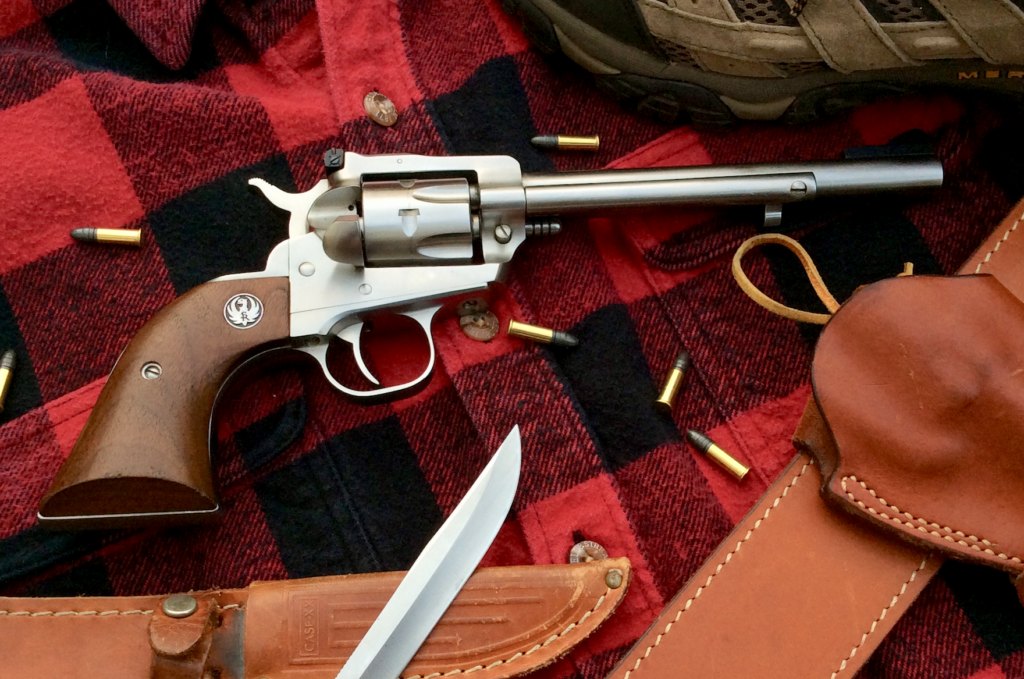
Yet, despite this affinity for the trigger-cocking guns, I still have a fondness for the single actions. There’s something special about the single actions which stirs the emotions and pleases the eye. Perhaps it has something to do with being raised on a steady diet of TV westerns, my interest in the history of the American West, or just the grace and beauty of these guns, but they never fail to grab my attention when I see them. I may not have a safe full of them, but I’ve been chipping away at it for decades!
Slow Burn
Since I started out with a Single Six, it’s perhaps not surprising that all of my single actions are Rugers, and most of them are .22s. I’ve shot and admired some wonderful guns from Colt, Freedom Arms, Magnum Research, and a host of other makers, but I’ve never purchased any of them. I came close, several times, but there was always some other gun that seemed to take priority.
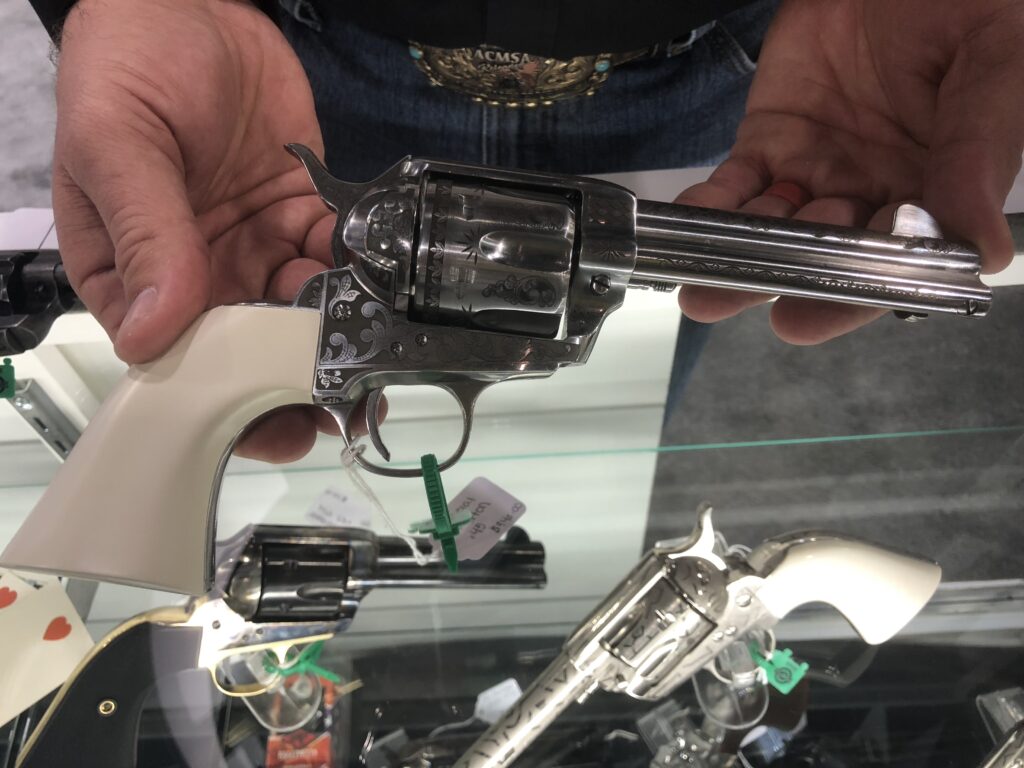
I’ve been longing for a Single Action Army (SAA)-type design for quite some time though, so I’ve been spending more time hovering around the booths of all the “likely suspects” at SHOT Show the past several years. The real Colts are always fun to look at, but the limited and irregular supply of them, coupled with the elevated price tags, have always pushed them into the “maybe someday” category, for me. The more affordable and available Italian clones from brands like Cimarron, EMF, and Uberti have captured more of my attention, as a result, and I’ve been slowly plotting to add one to my battery.
Brake Lights
The seemingly endless chain of ammunition crises that we’ve endured since the 9/11 Terror Attacks has cooled my jets a bit, though.1 It’s one thing to have a neat gun, and another thing to feed it, and I must admit that my concern about the latter has been a big part of my hesitance to “pull the trigger” on a new .44 or .45 caliber single action revolver.
For several years, it’s been nigh impossible to find .44 or .45 caliber revolver ammo at my local-area stores, and on the few occasions where I actually stumbled across some, the price was high enough to cause vapor lock.

Even a .357 Magnum SAA has seemed to be an unrealistic proposition for quite some time. This ammo was already pretty scarce and expensive before the latest panic began, and it’s all but disappeared, since. I might occasionally see a box or two of exotic and expensive .357 Magnum ammo on the shelves around here, but you certainly don’t find any good training or plinking ammo for sale in the caliber. Additionally, it’s only been in the last four to five months that I’ve started to see the supply of its little brother, the .38 Special, make a recovery—and even then, there’s not many choices to be had, and the prices are hyperinflated.
For several years, all the major manufacturers have been so busy making .223/5.56mm and 9mm that there’s been little-to-no machine time available to make revolver cartridges. My friends in the industry tell me that’s starting to change, but the honest truth is revolver cartridges don’t rate too high on the priority list—I think the majors are more concerned about restoring the .380 ACP supply than the .38 Special or .357 Magnum supply, so it will be a while before depleted shelves are properly restocked with revolver ammo.
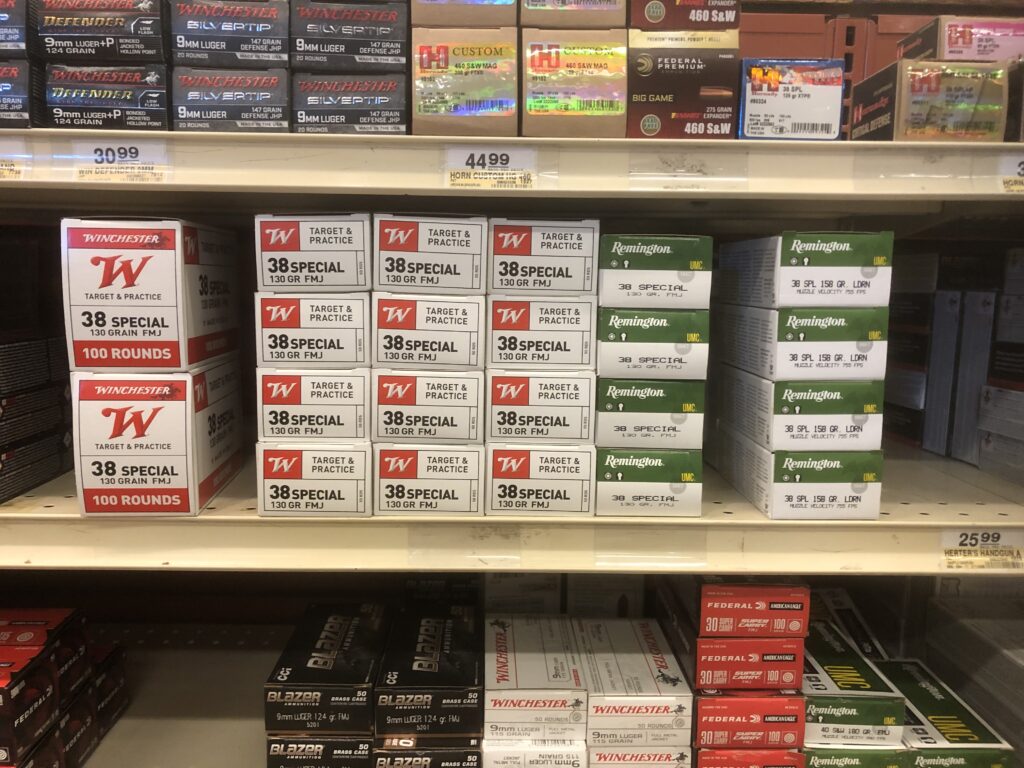
The handloaders out there who were savvy enough to stock up on primers, bullets and powder have been the only ones who could enjoy their .32s, .38s, .357s, .41s, .44s and .45s without too much drama the past few years, but even many of them have been concerned about their inability to replace the primers and powder they’ve been using up, and have hesitated to exhaust too much of their supply. Handloading is a great way to blunt the effects of ammo panics, but I’m not a handloader yet, and I’m not about to jump into that market while supplies are tight and prices are high. It’s not a viable solution to my problem, right now.
I stockpiled the ammo that I needed in between the panics of the last several decades, but that didn’t include .44 and .45 caliber revolver ammo, so my shelves are bare. I’ve been able to shoot my favorite calibers during the present panic without interruption, thanks to my carefully prepared stash, but adding a new caliber is not in the cards, under the current conditions. I could feed a .357 Magnum Single Action Army with my existing stocks in that caliber, but only if I was willing to make a dent in the ammo I’ve set aside for my double actions, which I’m hesitant to do. After all, election season is drawing near, and we all know that means another round of panics is on the horizon.
So, the Single Action Army (SAA) keeps getting bumped out of the lead position on my wish list, in favor of guns that I have a decent supply of ammo for, already.
Hallelujah!
I think the good folks at Taylor’s & Co. understood my plight, and recognized that I wasn’t alone, when they decided to create the gun we’re taking a look at here, the TC9.
The TC9 is an 1873 Single Action Army (or “Peacemaker,” or “Model P,” for some of you) design chambered for the 9x19mm (9mm Luger) cartridge. While this may, at first, seem an odd choice for a revolver of this type, the pairing of this popular autopistol cartridge with the SAA design is truly inspired, in my view. The 9mm Luger is the world’s most popular, plentiful, and affordable handgun cartridge, and chambering the Taylor’s & Co. 1873 Cattleman New Model revolver for this industry standard dramatically improves our access to these guns.
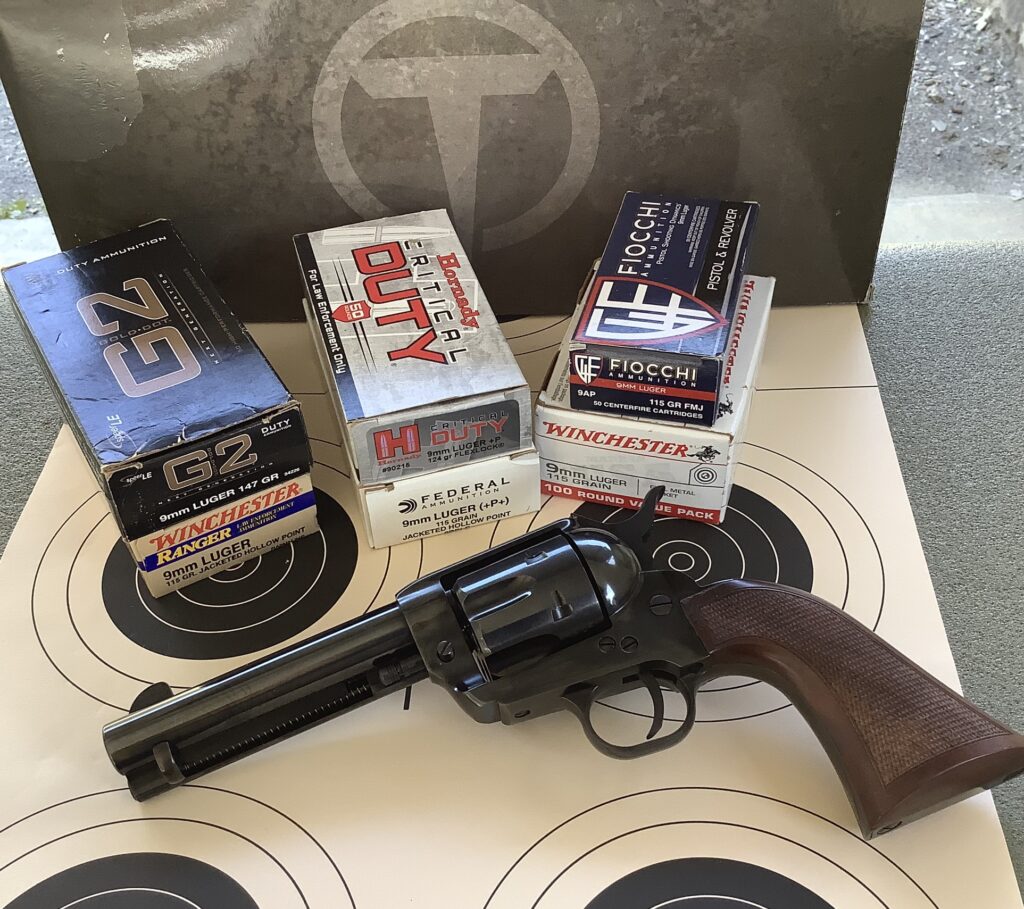
Who among us doesn’t already own a healthy supply of 9mm ammunition? Veteran shooters are likely to have a robust stock of 9mm for the autos they routinely carry and train with, and even the newest members of the shooting community are likely to have centered their purchasing efforts on the 9mm, which has become the de facto standard for military, law enforcement, sporting, and self defense use. Even during the height of the recent ammunition panic, the 9mm was the one centerfire cartridge that you were most likely to find.
So, Taylor’s decision to chamber their 1873 Cattleman New Model in 9mm significantly broadens their market, by appealing to shooters like me, who always wanted to own a gun like this, but were stopped by the economic realities of sourcing ammunition in the traditional calibers for these guns.
Additionally, the 9mm is known for its light-to-moderate recoil, which will endear the TC9 to shooters who are deterred by the greater recoil produced by .44 and .45 caliber cartridges. With a recoil impulse hovering between typical .357 Magnum and .38 Special loads, the 9mm fits into that “Mama Bear” category where the recoil is “just right” for the performance achieved. The 9mm offers good terminal performance (a major step up from the rimfires that inhabit the lower rungs of the single action revolver ladder), but won’t beat you up like the large caliber cartridges. As a result, even the most recoil shy shooters have nothing to fear from shooting the TC9.
So, even though it sounds a little strange to chamber this classic design for a metric autopistol cartridge, the case for the TC9 makes a LOT of sense to this RevolverGuy.
Let’s take a closer look at it.
Models and Features
The Taylor’s & Co. 1873 Cattleman New Model series of guns generally follow a standard pattern. These are steel frame guns with cylinder pins that are held in place by spring-loaded, cross-pin screws. The ejector rods are tipped with a crescent-shaped tab, instead of the round, “bullseye” shaped tab that’s found on early guns . The Cattleman New Model frames and hammers are generally case-hardened, while the cylinder, barrel, and other parts are blued. The Cattleman grip is the standard, “Navy” style that migrated from the 1851 percussion model to the Single Action Army, but the Cattleman’s squared, front sight blade and its rear notch are both wider than the original SAA standard.

As part of the Cattleman New Model family, the TC9 generally follows this pattern as well, but Taylor’s & Co. was wise to offer several variations on the theme which deviate from the standard protocol. The initial, 2022 launch of the TC9 included four different models, to include the following:
-
-
- A 4.75” version with case-hardened frame and blued parts, featuring a “Navy” size grip with two-piece, checkered black plastic panels;
-
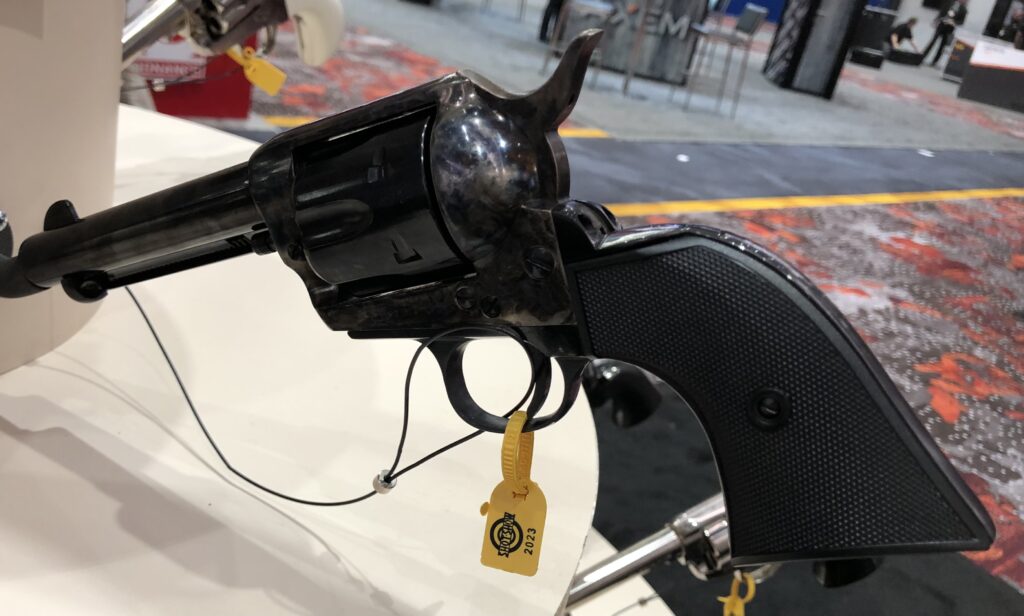
-
-
- A 5.5” version equipped the same;
-
-
-
- A 4.75” version with polished blue frame and parts, featuring an enlarged “Army” size grip with one-piece, checkered walnut stocks, and;
-
-
-
- A 5.5” version equipped the same.
-
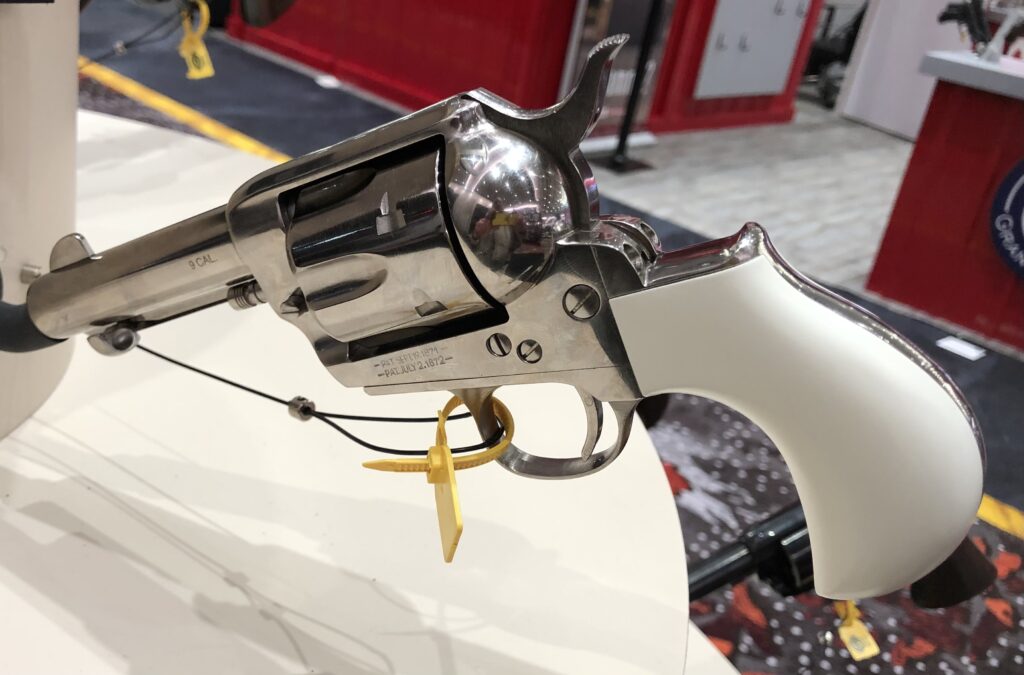 Since then, Taylor’s & Co. has also catalogued a 3.75” Flattop Birdshead Ivory model, with a nickel plated finish, and a one-piece, flattop birdshead grip that is made from polymer, but resembles ivory.
Since then, Taylor’s & Co. has also catalogued a 3.75” Flattop Birdshead Ivory model, with a nickel plated finish, and a one-piece, flattop birdshead grip that is made from polymer, but resembles ivory.
Choosing Sides
Taylor’s & Co. announced the TC9 series in the summer of 2022, but I didn’t get my eyes and hands on the guns until the 2023 SHOT Show, where I was immediately drawn to the models with the “Army” grip frame. The “Army” moniker comes from the .44 caliber, Colt 1860 Army Model revolver, which sported a grip frame that was longer than the one found on the smaller, .36 caliber 1851 Navy Model. This longer grip frame provides enough space for the pinky finger to fully grip the frame, instead of getting “half a grip” or curling below it, as many people are forced to do on the 1851 Navy or 1873 Single Action Army frames. With my large hands, I had no problem getting a full firing grip on the TC9 equipped with the Army frame, so it felt much better in the hand than the models with the standard, 1873 grip.

The 5.5 inch-barreled guns have a very nice balance in the hand, particularly with the full Army grip, but I was rather smitten with how well the shorter, 4.75 inch guns handled. They point well, and seem nimble in the hand. The shorter barrel makes the gun easier to carry, and faster out of the holster, too.
I was attracted by the colorful and beautiful case-hardening on the guns with the shorter Navy grip, and almost fell for their Siren Song, but the feel of that big Army grip sealed the deal for me, and I requested one of the 4.75” Army models for testing.
Details
My sample of the 4.75” Army TC9 arrived in a nicely-fitted Styrofoam box with an attractive cardboard sleeve bearing the logo, “The New West Has Arrived,” and indeed, it had. Metric calibers in cowboy guns? Yep, New West.
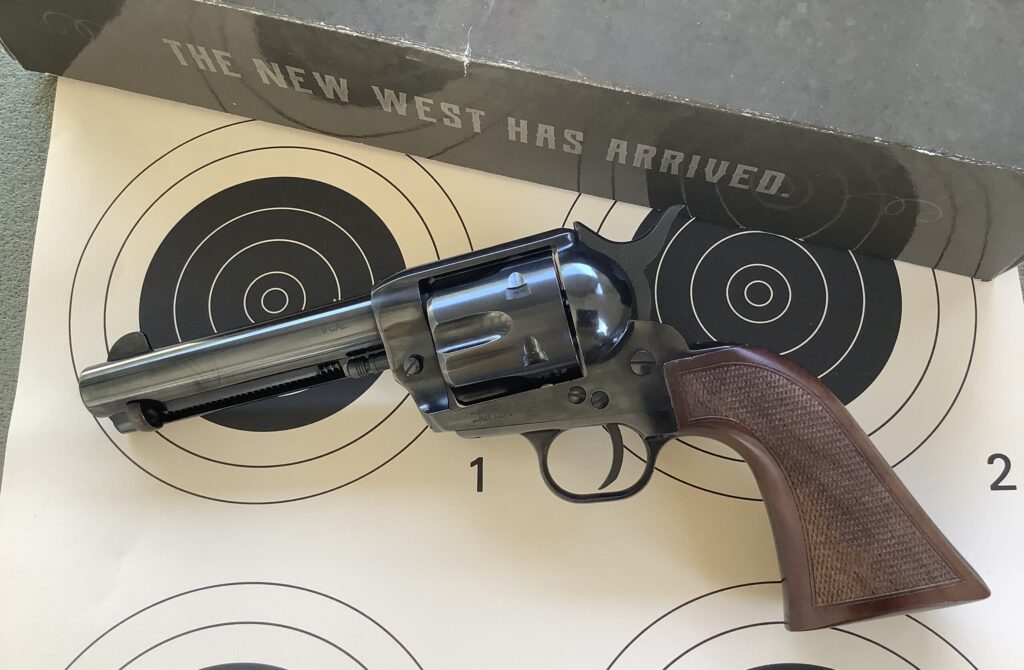
We’ve mentioned the larger Army grip and its one-piece, checkered walnut grip already. The grip fit the gun nice and tight, and followed the lines of the frame closely. Mine has a small cosmetic flaw—just a rough edge around the top corner on the left side, where it meets the frame—but it’s a minor complaint. The checkering is nicely done, not too aggressive, and has a clean border around it. It improves the purchase on the gun (not that a 9mm is going to kick much) and gives the gun a classy look.

The hammer on the TC9 is standard, with a tall ear and a firing pin mounted in its face. Some of the Taylor’s & Co. guns (in the Runnin’ Iron and Gunfighter Defender series) feature a lowered and flared hammer spur that makes it easier to cock the gun with the shooting hand thumb, and aids in faster sight acquisition, but this one requires the normal reach. I didn’t find it awkward to reach the spur with my shooting hand thumb, courtesy of my larger hand, but most folks will probably thumb it back with their support side thumb, which is more efficient, anyhow.
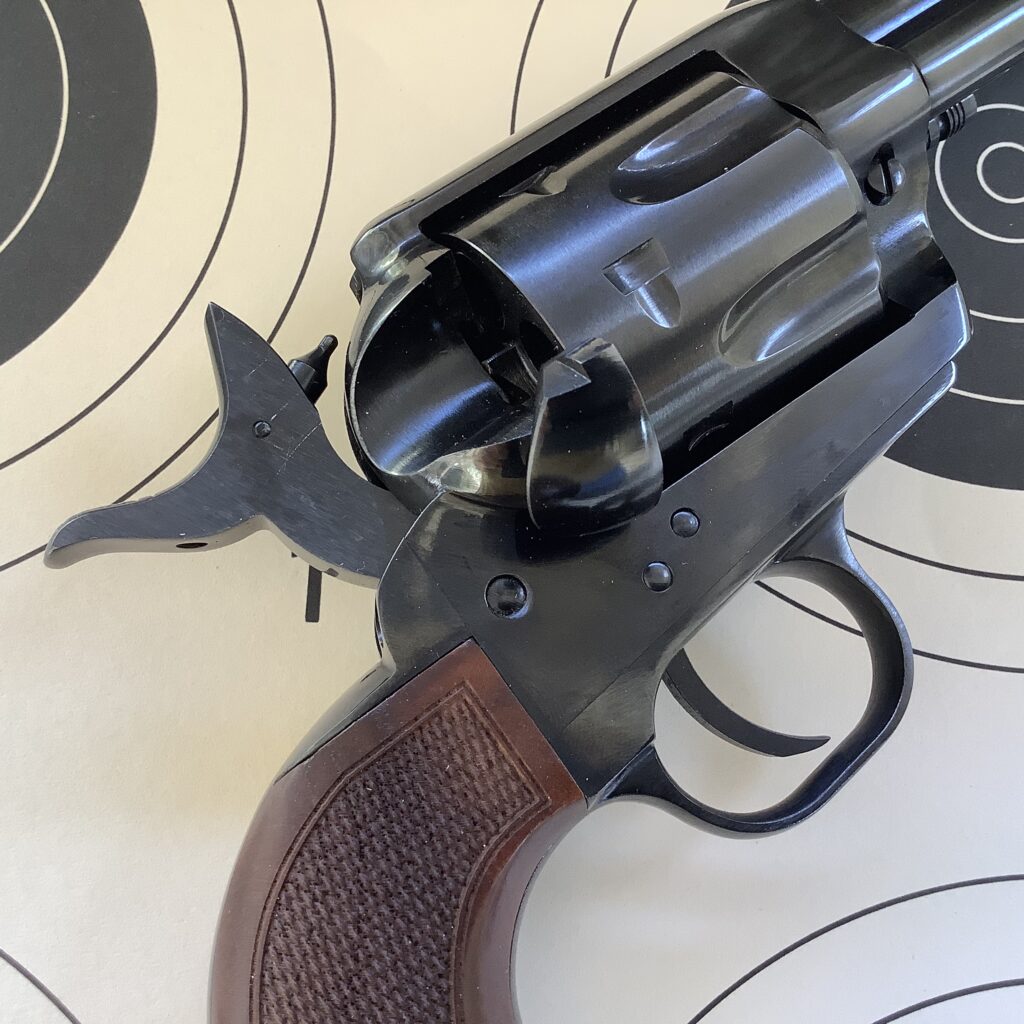
The cylinder is retained by the spring-loaded, cross-pin screw arrangement that crept into the First Generation SAAs around 1892, and became standard in 1896, around serial number 164100. This system replaced a single screw that screwed into the front of the frame, to secure the cylinder pin.2 The front edge of the TC9 cylinder has a more aggressive bevel/radius than you’ll find on the originals, and I found it very pleasing to the eye. I’m sure it will allow me to holster the gun with less drag, when I finally get a good scabbard for it.

The chambers on this cylinder are bored so that the rimless 9mm cartridges headspace on the mouths of the tapered cases. There’s no need for any problematic moon clips to secure the cartridges in this single action, as you’ll find in most of the double action revolvers chambered for the 9mm auto.
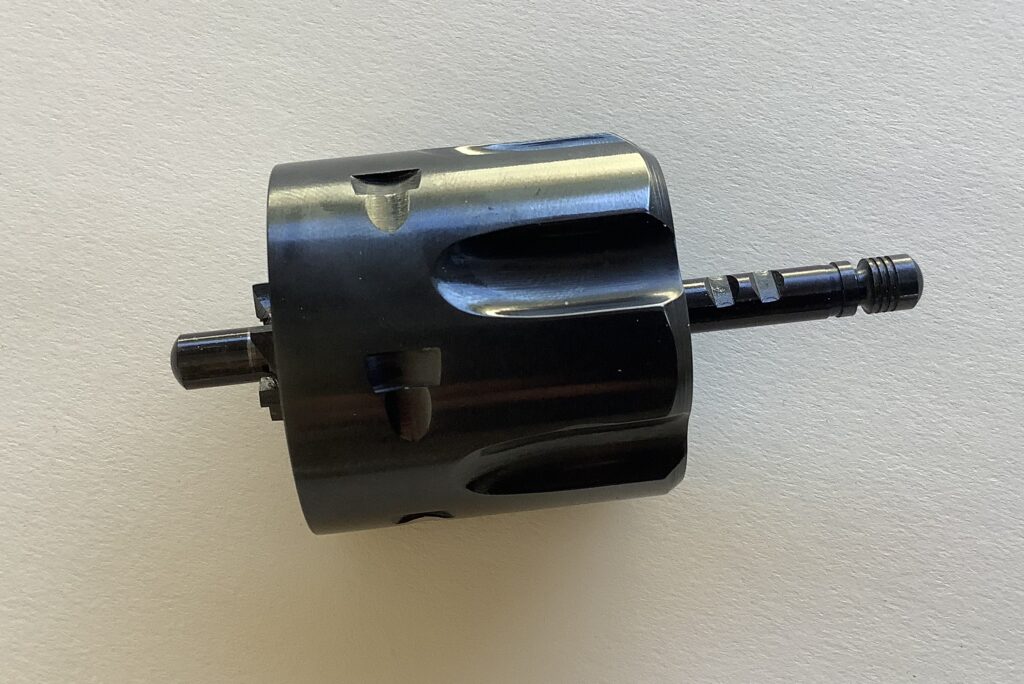
The cylinder pin is worth a mention, because it incorporates a unique safety mechanism. The cylinder pin has two cutouts for the spring-loaded, cross-pin latch to secure it. The aft position is for normal use, but if the cylinder pin is inserted deeper, and locked into position using the forward notch, its tip will extend through the rear of the frame and prevent the hammer from falling completely forward. This mechanical block keeps the hammer’s firing pin from reaching the primer, thus disabling the gun. I suppose this feature could be useful for some storage or transport applications, but I think its primary purpose is to score import points. Just make sure that you secure the cylinder pin in the proper notch when it’s time to shoot!
The trigger face on the TC9 is relatively broad and flat, with square corners. The square corners would be a problem on the double action triggers I’m most accustomed to, but are less of an issue on this single action gun. I could still feel them while shooting, and will probably break the edges at some point down the road.

The barrel on my TC9 is 4.75” long and marked “9 CAL” on the left side. The right side is unmarked. The front sight follows the traditional SAA shape, but is a bit wider and it doesn’t have the traditional taper–instead, it has a square profile, which I really like, because it’s easier to see with my aging eyes. I don’t know if the TC9 barrel has a true 9mm (0.355”) bore, or if it’s a .357 caliber barrel that’s simply marked for 9mm, but the difference is probably more academic, than practical, for most of us.
The ejector rod housing is securely mated to the barrel and runs its entire length, on this 4.75” model. The ejector rod has a crescent-shaped tab, instead of the circular tab that’s found on Taylor’s & Co. “Old Model” frames. I found it easy to operate, and didn’t encounter a single hangup on any of the spent cartridge cases.
In an era where we’ve become accustomed to gaudy, full size logos, graphics and safety warnings on our guns, the TC9’s markings are delightfully sparse. Aside from the “9 CAL” barrel marking, and the serial number on the bottom of the frame, the only other prominent markings are the historical 1871 and 1872 patent dates stamped on the left side of the frame, below the cylinder. This simplicity, combined with the polished blue finish and the warm-looking walnut stocks, make the TC9 a very handsome gun, indeed.
Manual of Arms
The TC9’s manual of arms is classic SAA, all the way.
The hammer has four positions, and the action makes four clicks as the hammer is cocked. To explain these, let’s step through the firing sequence.
As the hammer is drawn to the rear, it reaches the safety position at the first click. This position holds the hammer back far enough that the firing pin no longer protrudes through the breech face of the frame. Pulling the trigger will not lower the hammer from this safety position, which is intended as a safe landing spot for someone who starts to cock the hammer, but then changes their mind and lowers it. It is also used as the position for carrying the gun, after the hammer has been lowered onto an empty chamber.
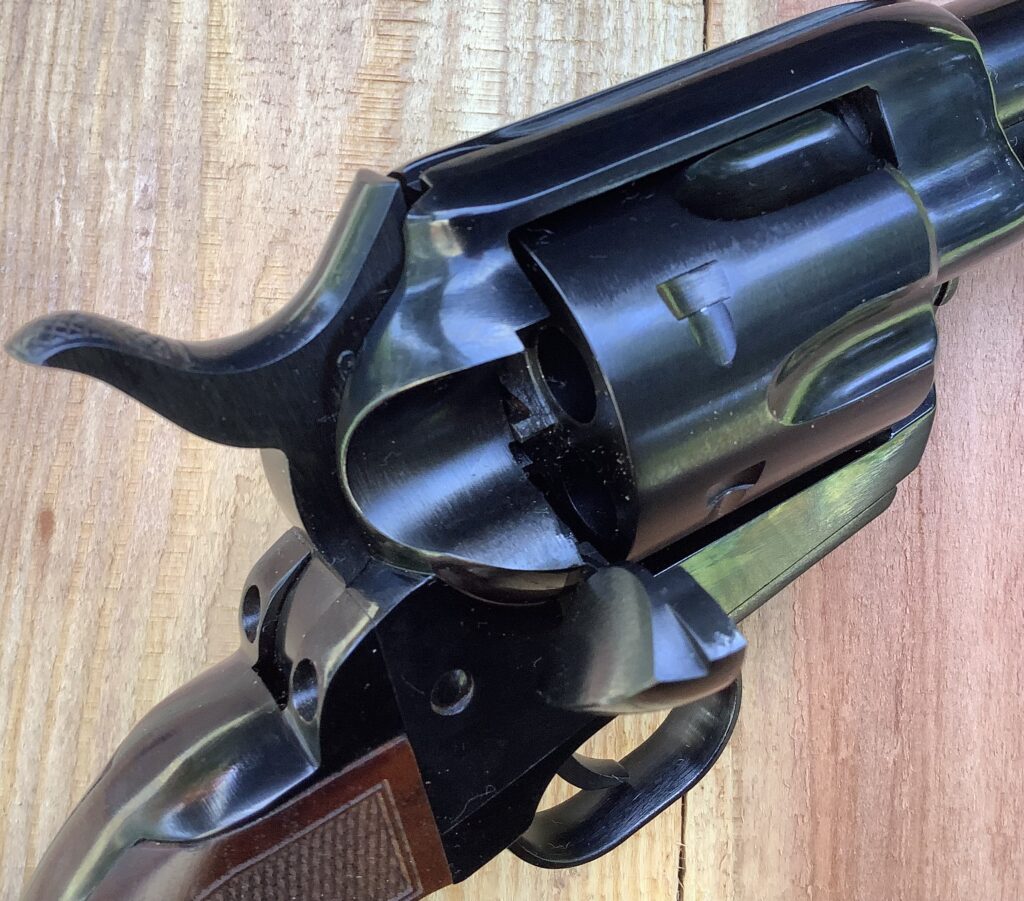
As the hammer continues to be drawn to the rear, it reaches the half-cock position at the second click. The hammer will remain at half-cock when it is released, and will not fall forward if the trigger is pulled. At half-cock, the cylinder stop is lowered into the frame, and the cylinder is now free to spin for loading and unloading, through the open gate on the right side of the frame.

As the hammer continues back, the third click is heard when the cylinder stop pops back up, and locks the cylinder in place. If the hammer is released at this point, it will fall forward to the half-cock position.
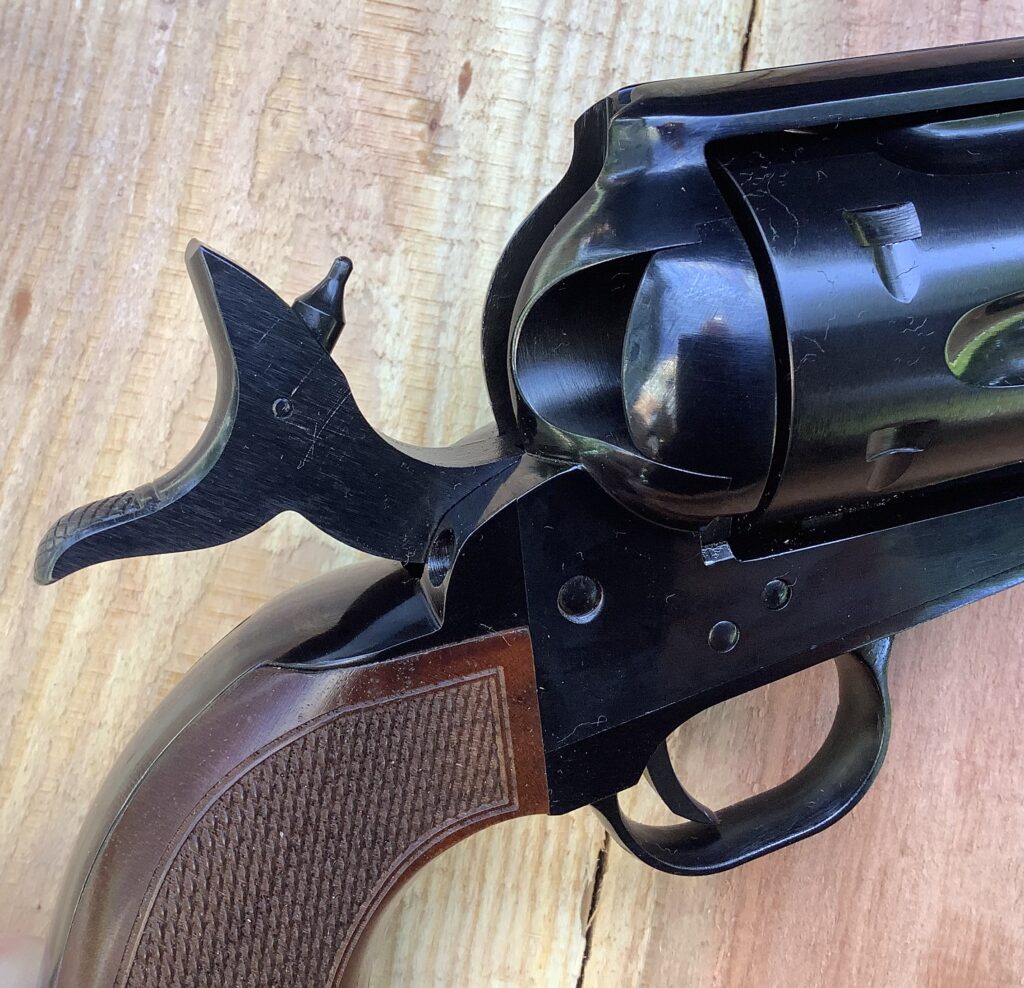
When the hammer reaches its full aft travel, it locks into place with the fourth click. When released, the hammer is fully cocked and the gun is ready to fire with a trigger pull, which will send the hammer fully forward, to its fourth position, where the hammer-mounted firing pin protrudes through the breech face, and contacts the primer.

The classic method for loading a SAA-style revolver is to “Load One, Skip One, Load Four.” With the hammer at half-cock, the loading gate is opened and the cylinder is turned to line up a chamber with the loading chute. One cartridge is inserted into the first chamber, then the cylinder is turned clockwise past the next (second) chamber without loading it. The third, fourth, fifth and sixth chambers are then loaded. After that sixth chamber is loaded, the cylinder is not turned again. The loading gate is closed, and the hammer is brought back to the fully-cocked position. While pointing the firearm in a safe direction, the trigger is pulled and the restrained hammer is lowered onto the empty second chamber, underneath. The hammer is then pulled back slightly to the safety position, and the gun can now be safely holstered.
Sight Regulation Woes
There are a few things which immediately become evident when you’re shooting the TC9. First, it’s a LOT of fun! Second, it follows the SAA tradition of sight regulation.
Let’s get the bad part out of the way, first. Like all SAAs, the TC9 is equipped with a front sight that is much too tall, which leads to poor sight regulation. The original Colts were all built with front sights that were taller than required, to allow the user to file them down for the desired point of impact with a given load.3 True to form, the Italian-produced clones all follow the pattern, including this import from Taylor’s & Co.
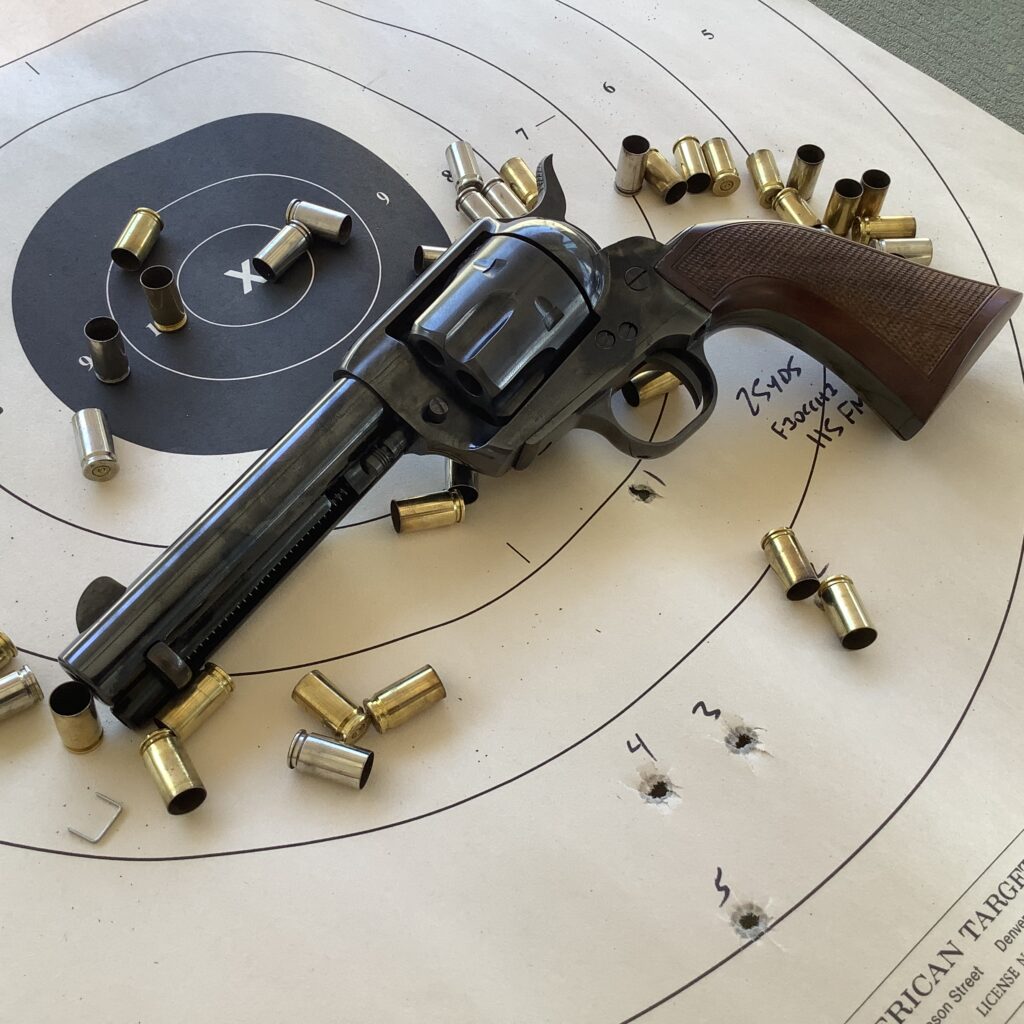
I shot my TC9 with 115, 124 and 147 grain 9mm loads from a sandbag rest at distances of 15 and 25 yards, to see how the point of impact would change. All of the loads struck well below the point of aim due to the unnecessarily tall front sight. The following table summarizes how far below the point of aim the rounds struck, on average:

This can certainly be fixed with the judicious use of a file, but it’s disappointing and frustrating that this new gun will require such work. Longtime SAA shooters are so accustomed to having to file their sights that it’s probably more of a nuisance than a point of concern for them, but I think the TC9 is particularly unique, and deserves sights that are regulated straight from the box.
Taylor’s & Co. is hoping the 9mm TC9 will be a “gateway gun,” and attract buyers who have not previously owned SAA-style guns. These buyers will not understand that filing their sights is just an accepted part of the SAA landscape, and I don’t think many of them will be eager, or prepared, to take a file to their beautiful, new gun.
And why should they be? If these customers went out and spent the same kind of money on a semiauto 9mm—any semiauto 9mm–the gun would hit to the sights. Even the crummy, plastic “dovetail protectors” on the Glocks would hit to the point of aim, as they should. It should not be unreasonable to have the same expectation of the TC9, and I wish Taylor’s & Co. had addressed it with the manufacturer (Pietta, in Italy).4
Accuracy
Aside from the elevation issue inherent to the poorly-regulated sights, the TC9 seemed to shoot well, with one concern that I’ll discuss in a bit.
I shot three different loads in the TC9 at 15 and 25 yards from a sandbag rest to get an idea of its accuracy. Now, I don’t claim to be an exceptionally talented shooter, but I’d rate myself above average, and I’m usually pretty consistent on the trigger, so I think the results I obtained will be reflective of what the average RevolverGuy can expect, even if the gun could have shot tighter groups with a better nut behind the trigger.
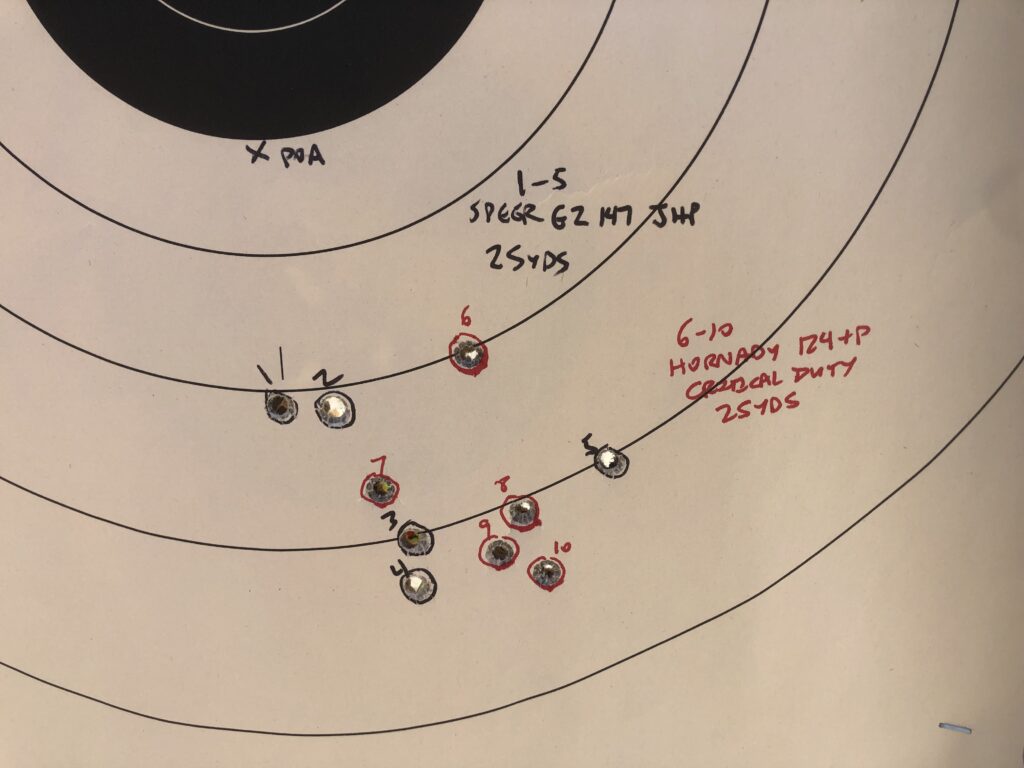
The sights on the TC9 seemed to be well-adjusted for azimuth. Most groups were just an inch or two right of center at 25 yards, but on center at distances of 15 yards and closer. I’m not ready to blame the gun for the windage error, and will just chalk it up to shooter technique, for now.
Here’s the results for the best three out of five shots (and all five shots, in parenthesis), for all the loads tested:

When I brought the targets home from the range and started measuring them, I noticed a recurring trend where my groups looked like “3 and 2”—three rounds in a cluster, separated by several inches from two rounds in a cluster. The trend was apparent at both 15 and 25 yards, and presented with each of the loads I tested.
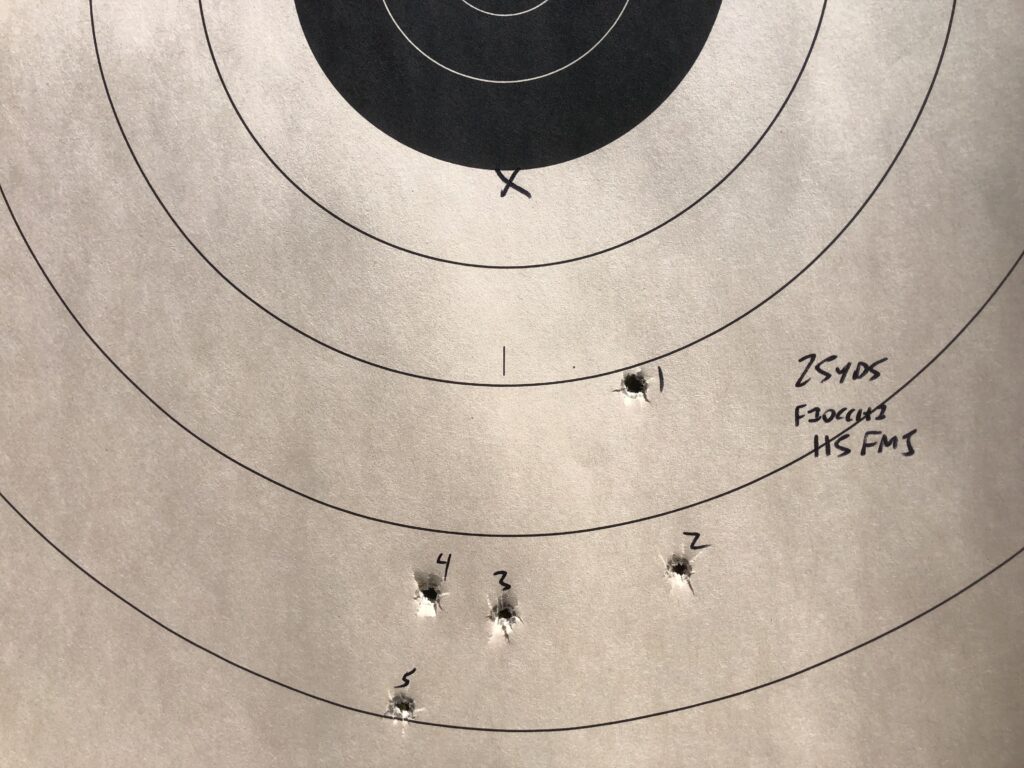
It’s possible this could simply have been the result of shooter error, but I suspect this particular gun might have a few chambers that throw shots wide, as a result of how they were drilled, or how they are timed. I’ll be monitoring it as I continue to shoot this revolver in the days ahead.


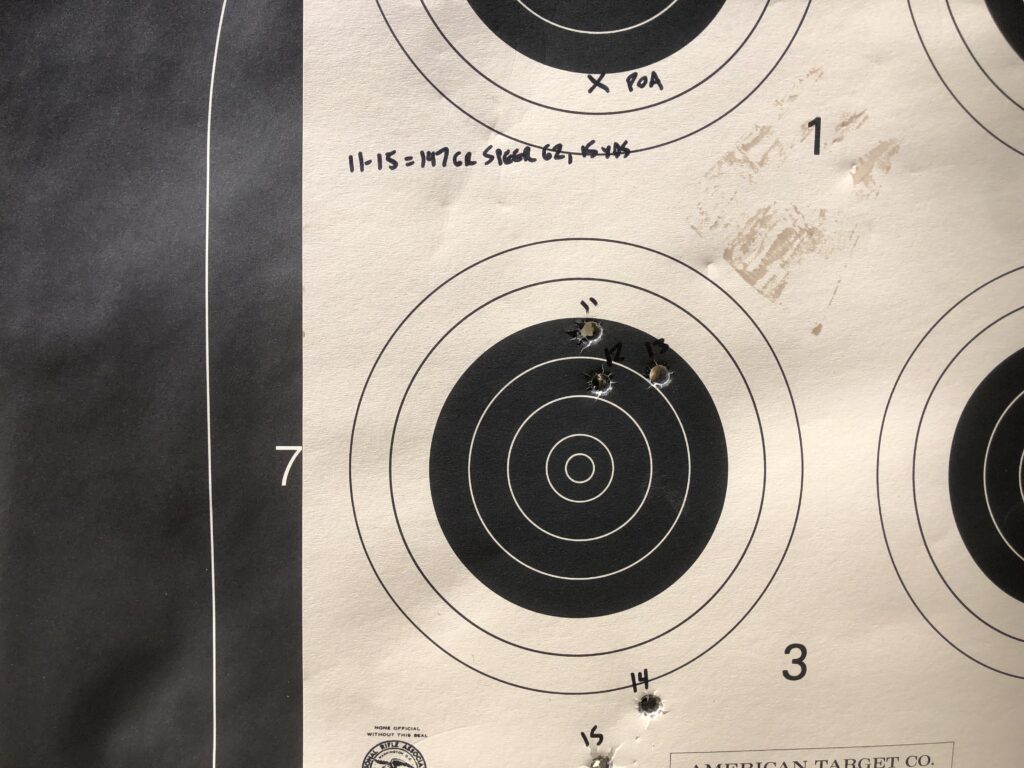

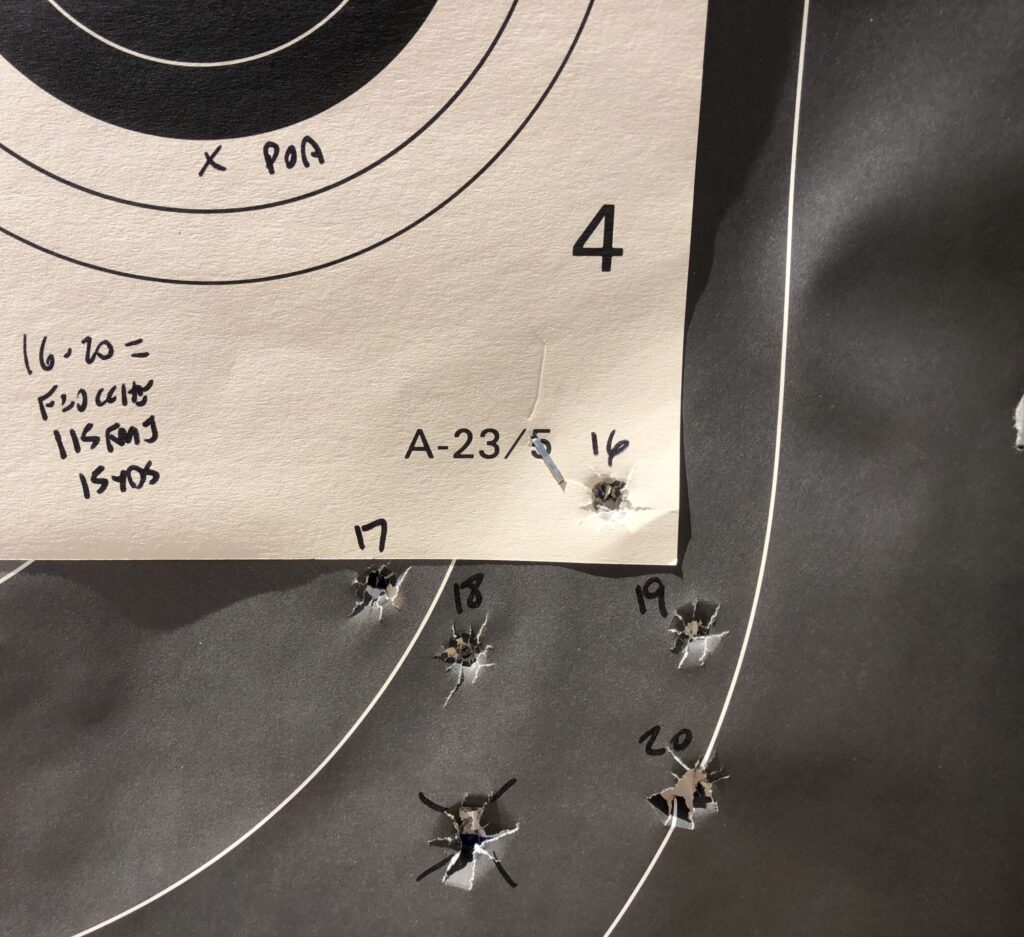
This was not an exhaustive test of the TC9’s accuracy potential, but I think it’s a reasonable snapshot of how the gun performs. I’ll probably revisit this later, when I have even more trigger time on the gun.
Handling
Despite my disappointment about the sight regulation issue, and the “3 and 2” pattern, I found the TC9 to be a very pleasant and enjoyable gun to shoot.
There’s something very satisfying about working a single action revolver, and feeling the cylinder turn and lock into place as you thumb back the hammer (spelling C-O-L-T with each of its four clicks). A short trigger pull frees the hammer to fall with a mighty thunk and the roar of ignition, leaving you grinning from ear-to-ear, as you play out your childhood cowboy fantasies in your head.
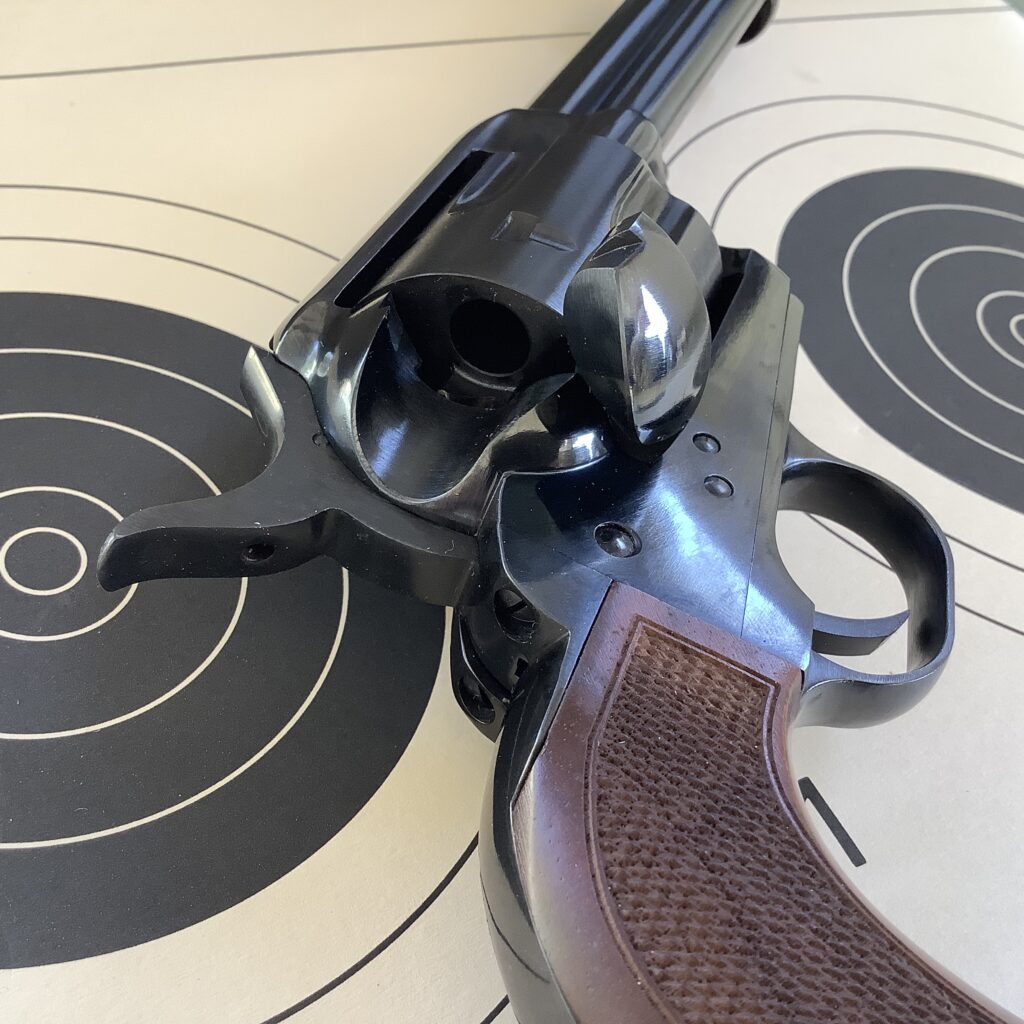
The TC9’s action was smooth, with a trigger pull around four to five pounds, and the ejector rod shucked all the empties out without much effort. There was a little evidence of rubbing on the side of the TC9’s hammer, but I didn’t feel any drag as I cocked it.
I had wondered if I would pull any of the bullets out of their cases when I fired the gun, as I’ve encountered on some 9mm snub revolvers, but it didn’t happen with the TC9. I suspect the gun’s greater curb weight dampens the intensity of the recoil impulse and stretches it out over a longer period—flattening the curve, if you will—which causes less inertial pull on the bullets. I didn’t have a single cartridge “self-disassemble” inside the cylinder as I shot the gun, which was welcome, indeed.
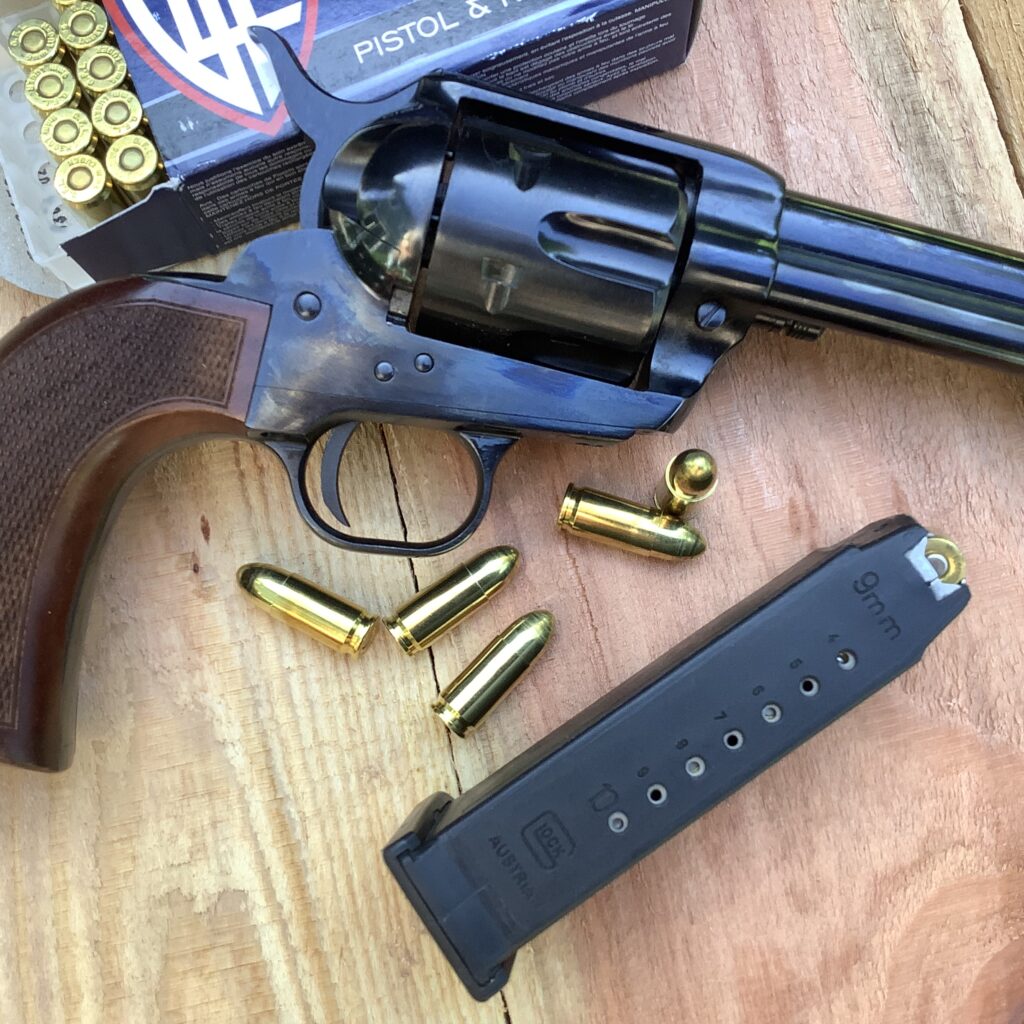
The recoil impulse of the 9mm ammunition I fired in the TC9 was mild, but the gun did exhibit more muzzle flip than the typical 9mm auto, firing the same ammunition. This is a result of the TC9’s higher bore axis, its grip shape, and the lack of a recoil spring and moving barrel/slide assembly to absorb and redirect the recoil energy.
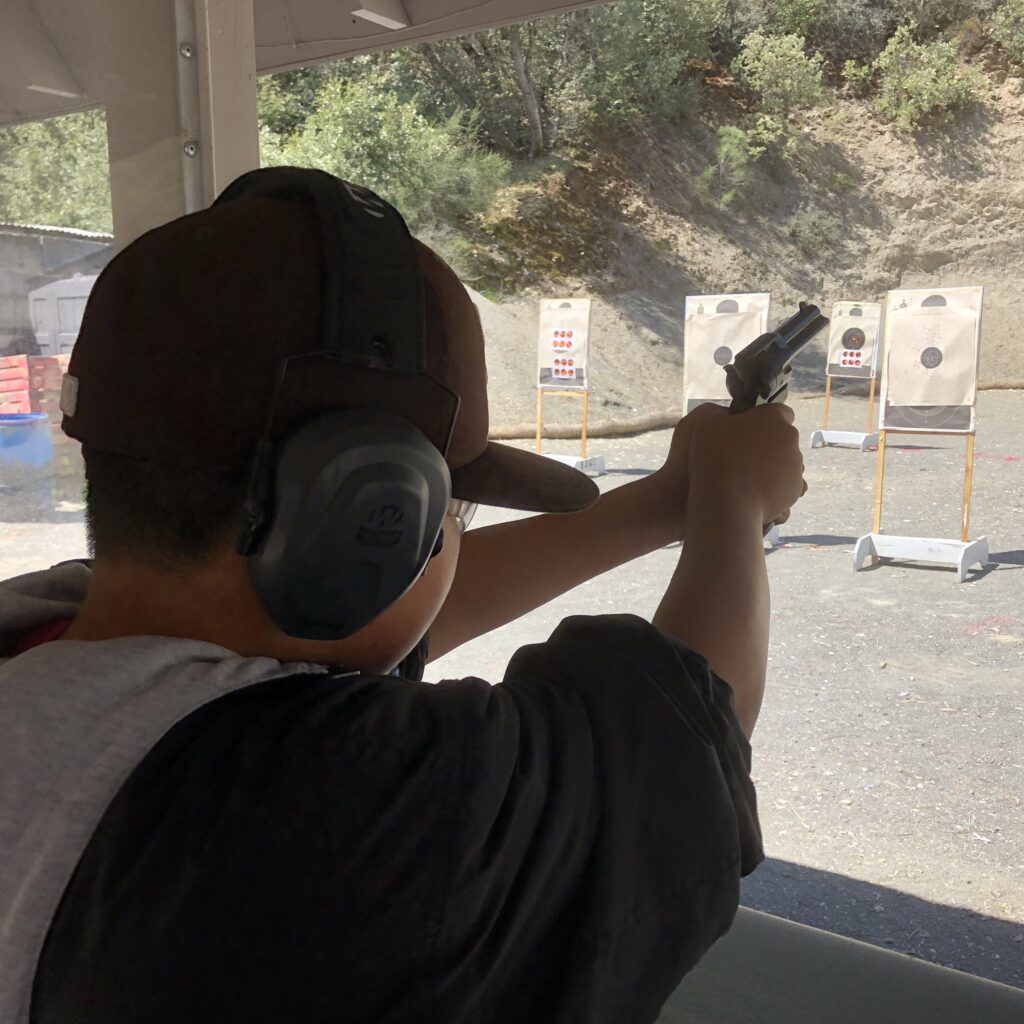
I didn’t find it distracting or uncomfortable, though, and neither did my friend’s young boys, who were eager to help me test the TC9. The gun will recoil more than the rimfire single actions that are so popular, but as far as centerfires go, this one’s a pussycat. Even the recoil shy will enjoy shooting the TC9.
A quick cautionary note is in order. At one point during my shooting, I removed and replaced the cylinder, but apparently failed to get the cylinder latch properly nestled in the cut on the cylinder pin, so the pin began to walk out of the gun during recoil. I caught it when I went to unload the gun, and was thankful that it hadn’t come all the way out. Learn from my example and make sure you give the cylinder pin a little tug to ensure the latch is properly engaged, before you start shooting.
Dance!
After all the bullseye shooting, I wanted to try something a little more fun, so I chased a small scrap of 1×2 wood stick all over the range, by firing from the hip. It took a few rounds to get dialed in, but I was soon landing shots within a few inches of the target out to about 10 or 15 yards, and even hit it square a few times. I wouldn’t have been too excited about doing this if I was shooting ammo that cost me a couple bucks a pop, but at 9mm prices, I wasn’t wincing every time I pulled the trigger.

The old gunfighters spoke highly of the natural pointing qualities of the SAA, and I could certainly appreciate that after playing with this 4.75” TC9. It’s understandable why some of the “transitional lawmen” of the early 20th Century held onto their SAAs while others around them adopted “more advanced” designs like the S&W Hand Ejectors or the Colt 1911 auto.
Wrap Up
I think the Taylor’s & Co. TC9 is going to appeal to a broad market. The new members of the gun culture, who are bored with their Glocks and are looking to branch out into something different, will really enjoy it. RevolverGuys like me, who want to shoot a “cowboy gun” with a more substantial punch than their rimfires, but don’t want to break the bank, will also enjoy shooting the TC9.

You could make a pretty good case for the gun as a hiker’s or outdoorsman’s light duty sidearm. The 9mm is no .45 Colt, but you could definitely dispatch a coyote with one (or the more common two-legged miscreants that sometimes inhabit the wilds), and it would be easy to carry a supply of ammo for it in a spare pistol magazine.

The cowboy action shooters might be able to make pretty good use of it too, if they don’t fuss about the historical discrepancy of the caliber. It might be hard to keep the rimless 9mms from falling through the cartridge loops on their gun belts, but they can put some .38s in there for show, and save some money as they shoot.
But we don’t need to overthink it too much. Sometimes the best justification for a gun is that it’s just plain fun to shoot, and I think the TC9 definitely fills the bill. I’m looking forward to getting to know this one better in the days ahead.
*****
Postscript: As I was working on this story, Taylor’s & Co. announced they would be selling a 9mm version of the 1875 Remington revolver that was favored by the likes of outlaw Frank James. The Taylor’s & Co. 1875 Outlaw will be available in two models, with a choice of a 5.5 or 7.5 inch barrel. Each will feature a blued frame and a smooth, walnut grip.

I think Taylor’s & Co. has tapped into something good with these 9mm versions of the classics, and look forward to watching the concept expand to other designs in the days to come.
Endnotes
1. I don’t remember any huge “ammo panics” in the 70s, 80s, and 90s, outside of the Black Talon-inspired rush, circa 1993. I’m not saying there weren’t any, but I don’t remember a time during those years when I couldn’t find what I wanted for a fairly reasonable price. We all just assumed that there would always be plenty of ammo for our needs, and there was.
Even during the Clinton years, when the anti’s were busy banning guns and trying to destroy our 2A rights, I don’t recall seeing any bare ammo shelves. Prices for the domestic brands remained pretty stable and there was plenty of cheap import ammo on the market (from China, Greece, Egypt, the ComBloc nations, and others). You could still find a brick of .22s at the store without breaking a sweat or spending more than ten bucks.
The first significant ammo panic that I witnessed was the Y2K-inspired run on guns and ammo, which drove availability down, and prices up. It didn’t seem to last very long though—when everything didn’t implode on New Year’s, things cooled down pretty quick.
Not for long, though. The 9/11 attacks in 2001 threw the industry into a tailspin, and created a real shortage, with staying power. Private and public demand for ammunition spiked, and the industry struggled to keep up with commercial and government orders. This was the first “bare shelf” crisis that I remember, and it lingered for a good three years, or so. Some of you will recall this was the crisis that created the guys who camped out in front of Walmart, to scoop up all the ammo when the doors opened each morning. Most of that ammo got sold at a markup at the gun shows.
We hadn’t fully recovered before the 2008 election cycle was upon us, and a new round of shortages kicked in, due to panic buying and a growth in the shooting population. When President Obama was elected, this turned the pre-election panic into a post-election panic that dragged things out for a few more years.
In a now-familiar cycle, we hadn’t quite got back to normal before the 2012 Sandy Hook-inspired attack on 2A kicked off a new panic. This one seemed to last throughout President Obama’s entire second term, and the runup to the 2016 elections. It was only President Trump’s election that took the foot off the gas pedal, and gave us the “Trump slump,” which was actually just a normal correction to a market that had been overheating for nearly 15 years.
The 2020 election cycle, and the response to the ChinaVirus, kicked off another panic that is just starting to plateau a bit, as this is written. We’re seeing some small corrections right now, but we’re still far from “normal,” with elevated prices and product shortages continuing. I think it will be a while before things settle down, and we figure out what the new water level will be;
2. Colt collectors frequently describe the frames with the spring-loaded latch system as “smokeless” frames, but that’s not an entirely accurate description, because Colt didn’t warranty the SAA for smokeless powder until 1898, around serial number 180,000 (other sources mark the transition point as 1900, around serial number 192,000). Therefore, a number of black powder-rated guns were produced with spring-loaded latches (at least 16,000 of them, and probably much more). An original, First Generation Colt SAA with the single frame screw is most definitely a black powder gun, but one with the spring-loaded latch may be either a black powder or smokeless powder gun, depending on its serial number. Of course, the modern reproductions which feature the “black powder” frame’s single screw are safe to shoot with smokeless powder;
3. Colt SAA afficionado Mike “Duke” Venturino has written about the US Army standards for sight regulation on the 1873s, but the details have slipped my mind in the intervening years. If I’m remembering it correctly, the US Army wanted the guns regulated so that a soldier could hit a horse-sized target at an optimistic 100 yards with the circa-750 fps, 250 grain, .45 caliber ammunition they fired. Since both .45 Colt and .45 S&W Schofield ammunition were issued for government SAAs at various times, the factory provided tall sights to ensure that Army personnel had enough room to dial in the sights on individual guns with some careful file work;
4. It’s frustrating that this issue keeps rearing its head in the revolver world. The SAA certainly isn’t alone in this respect—many of the fixed sight, double action revolvers also suffer from this malady, particularly the snubs. I’m not sure why the revolver makers don’t make it a higher priority to properly regulate their sights. Maybe it’s just corporate inertia in most cases, but even new designs, like the Kimber K6s, suffer from inattention in this area;


Taylor and Co’s TC9 and variants are fine lookin’ thumb-busters that Hopalong Cassidy, the Cisco Kid, Roy Rogers et al. might have been proud to carry in their buscadero rigs.
Ruger offers .357 Magnum/9mm convertible single-action revolver models, which allow a broader range of ammo fodder for wannabe cowpokes. Yeehaw!
Yes, I think T&C does a great job on their guns—very attractive, well built.
That’s quite an attractive combo from Ruger, too, Spencer. Melikes.
Very nice, thorough review.
It seems to me that a revolver with interchangeable cylinders in .357 Magnum and 9mm would be an ideal choice for getting through ammunition panics, due to the versatility. Ruger has offered the Blackhawk like this (and also a .45 ACP/.45 Colt version) for decades, but the Blackhawk is really heavy in .357/9mm. Hopefully, Taylor’s will see fit to offer such a version.
I respectfully disagree on the sight regulation issue. I prefer my fixed sight single actions to shoot low out of the box so I can file the front sight to zero it, after I settle on a load. A rugged adjustable rear sight would be the best option, IMO.
Finally, regarding reloading: I seriously doubt that components are going to get much cheaper and you never know when the next panic will strike. It’s not a bad idea to start accumulating components, tools, and manuals now so that you’re prepared for the next inevitable round of scarcity.
That’s not bad advice, Dave. Just wait until the next election season kicks off!
This looks exciting! In particular I’ve had a yearning for a bird’s head grip for a while, purely for the aesthetic. I’ll be keeping my eyes peeled.
Thanks again, Mike
It’s a pretty sexy looking gun with that grip. The Bird’s Head Wrangler would be fun, too.
Yes Sir it would! I’ll take what I can find.
9mm in a single action, it’s probably the epitome of simplicity and economy. Ruger introduced the ‘convertible’ concept on their Blackhawk and Single Six back around 1962-63 (somewhere in there) in an era when 9mm was that European pistol round to most shooters, and not commonly found as it is today.
Me thinketh Mike might develop a case of Single Action Thumb in the near future. Single actions to many Revolver Guys are addictive. In the era of everything striker fired polymer, taking one’s time on the range with being totally hands on with the gun is an exercise in relaxation. I shoot my autos to keep proficient to qualify with, but my single actions are invariably my constant range companions.
The lockup on a good single action is far more solid than on any double action wheelgun, and will digest far heavier loads for much longer durations. My .357 Blackhawks have been test guns for my experimental reloads for decades.
My Ruger Blackhawks have always been very inclusive – they have digested .357, .38 Special (and shorter versions), and 9mm . . . lots of 9mm. Fortunately, my ‘newest’ one shoots 9mm – including Federal’s 9BPLE load, with amazing accuracy given it’s a .355″ bullet going through a .357″ bore. Also, installing the somewhat lower wide spur hammer of the Super Blackhawk on the ‘regular’ Blackhawk, along with a Super Blackhawk grip frame makes a world of difference in handling. Where once in the 1970s, mine never shot 9mm rounds, now that’s about all that goes through them.
Mike mentioned surplus ammo, and that brings to mind some surplus Egyptian 9mm SMG ammo that came into the US in the late 1980s, early 1990s. The primers were hard as nails and would not fire in my service Glock; however, several thousand rounds of it went unwillingly through the 9mm cylinder of my Blackhawks.
With current ammunition supplies being what they are, this is a smart move on Taylor’s part since it fills the market for the traditional Colt style revolver action with a chambering that has become almost cheaper to buy than reload. .45ACP isn’t cheap anymore, but it’s a lot cheaper and easier to find than .45 Colt.
You’re not wrong! This, and another new gun I’m testing, have renewed my interest in the style! I’m having lots of fun giving my thumb a workout.
With the 9BPLE in a 4.75” or longer barrel, you’re almost there to a .357 Mag. Nothing to sneeze at.
I definitely think this was a win for T&C, and like the idea that you and others have floated here, about a .357/9 convertible version. That would be slick.
Excellent article, Mike.
Really enjoyed your critique on the gun, as usual.
As a cowboy action shooter I can tell you, I have never filed my front sights. Yes they shoot high when sighting, but I shoot CAS revolvers with both eyes open, for easier target acquisition since there are multiple revolver targets to engage at each stage. CAS targets are metal plates of different shapes, but mostly square, that are simple hit or miss. Typical size is 16×16″ and 7 to 10 ft away. No bullseye, hence not much necessity to take deliberate aim. I actually line up the front sight partially above the rear for quicker visual acquisition of the sight. I’m an average CAS shooter but typically shoot “clean”( that is no misses), at CAS shooting matches.
I’m sure these may sound too easy, but under the presume of a timer, the saying goes “There’s no target too close or too big that you can’t miss” lol
That info was all free. It’s a slow Saturday here. Hope you found it interesting.
Thanks Jim! I don’t shoot CAS, but was raised where it all began, in SoCal, and have watched the sport for decades. I’m constantly amazed at the skill demonstrated by the shooters—never would have thought you could run a SA sixgun or lever action rifle that fast. Heck, even the double shotguns are amazing, in the hands of a skilled CAS shooter.
I’ve been “shooting out of the notch” with defensive guns for many years, particularly the J-Frames, so I get what you’re saying about the flipside benefits of a taller front post. That’s definitely the track I’ll have to take, until I get the time and inclination to file on my sight.
Now, “Fill your hands, you son . . .” 😁
Thank you for the run down on the Taylor & Co. 9mm S/A, Mike. neat concept. I hope they can fix that sight regulation. Not sure why they (and a lot of other manufacturers) can’t regulate for middle ground bullet weights in a given caliber, like 124 gr. for the 9mm or 130 gr. for .38 Special guns. That would seem like a good rule of thumb.
I think so, too, Kevin. Nice middleweights that should drive a regulation that’s close enough for the rest.
My first experience with a rimless single action was one at 14 or so when I fired one shot through a SAA clone chambered in .50 AE. The checkering was sharp enough to tear up my hand a bit, and I nearly ended up with a front sight blade in my forehead. My dad’s hands fared better, but still hurt after six rounds (which he describes as five rounds too many). That experience always sneaks into the back of my mind when I see mention of rimless single action revolvers, but this one seems way more practical.
I’ve dabbled with the thought of a convertible .357/9mm Ruger Blackhawk, and this article bumped it back onto the list of serious considerations.
My only brush with the .50AE was in the Deagle, whose gas system and overall weight made it pretty darned manageable. I wouldn’t be eager to shoot it in a revolver! I think your dad had it right, Greyson!
Perfect caliber for the rod ejecting SAA. Modern HP bullets will work great in these guns because the barrel/cylinder length will produce proper expansion velocity. Cheap to shoot and it doesn’t throw brass all over the place!
Yep, I think it’s a winning combo, and hope we’ll see more offerings like this from T&C, and others,
Elmer Keith has all sorts of anecdotes about using the tall front sights on his Colts for hits at otherwise unobtainable ranges. I enjoy my Blackhawks a great deal, and am considering an Uberti Cattleman in 9mm next.
I don’t know if there is a thing called Kentucky Elevation, but that is my plan for a gun like this, and in 9, I won’t fret about all the point-shooting I am burning ammo to practice.
I didn’t see any mention of “suggested MSRP” on their least expensive model. Of course, “if you gotta ask,” ……..
Bob, the website shows a suggested price of $619.77 for the model I reviewed. The model with the Navy grip is less expensive, at $575.74
Sorry, I guess the Pahrump gun guys aren’t too sharp at ordering guns. Shame on me for not checking their website first. Thanks for your reply.
Bob, I just spoke to my contact at Taylor’s & Co., and he advises that the guns are in stock, and your dealer can call them directly and order one for you at dealer cost (there’s no minimum quantity for dealer orders). Additionally, you can order one from Taylor’s at retail, and have it shipped to your FFL for transfer.
The guns are just starting to get into distribution channels, and it sounds like Bill Hicks & Co., and Sports South Ltd. will be the primary distributors. Your FFL can check with them, too.
My apology for being way off topic here, but a few days ago I dropped in my local gun store and inspected three brand new Colt revolvers: two Pythons and one King Cobra. All had excellent fit and finish, and nice actions. The other thing they shared was noticeable cylinder end shake.
Over the years, I’ve handled a number of vintage Pythons and other Colt double-action revolver models and every one had almost no discernible end shake despite being shot quite a lot. So, what’s up with the new Pythons and Cobras? Did I just run into a bad batch, or is this a design change? If the latter, why?
Spencer, without seeing the guns, I’m not quite sure, to be honest. A QC issue? Possibly. I’ve been hearing some rumblings about QC in the new Colts, as they push lots of units out the door, but can’t confirm the rumors.
I think it’s possible that you’re discovering something about the new design, too. It’s important to note that the new Colts are using a different method to secure the cylinder to the crane, with a set of ball bearings on the crane that ride in a recessed groove inside the cylinder. This new assembly method can lead to a little “slop” in how the cylinder rides on the crane, but it’s part of the design. Colt actually feels these guns have a lesser chance of developing endshake with this new system, than a traditional Python would.
Good review of an interesting revolver! Ruger has offered 9mm as a convertible option in their .357 Blackhawks for a long time*, but this is the first dedicated 9mm single action that I know of (I’m sure there are others, I just don’t know of them).
*Sadly my .357 Blackhawk does not have a 9mm cylinder, but I’ve long thought I should contact Ruger and see if they can fit one. This inspires me to look into that sooner rather than later. 9mm ammo prices are very inspiring!
Regarding the front sight being too high – if the rear sight was adjustable, I’d agree with everyone that it ought to come regulated with middle-of-the-road ammo. Or if the front sight blade was interchangeable, same thing. But with fixed rear and an integral front, being too high is the only way to let owners decide for themselves how to regulate it. Middle-of-the-road regulation means anybody shooting something that goes low is stuck. A fileable front sight is a good solution. Unless you change your primary ammunition, it’s really a one-time thing. I realize that gun reviewers can’t make this kind of alteration to their samples – which is unfortunate, because it gives a slightly inaccurate (see what I did there?) view of what running a gun like this involves.
I see what you did! Well played, Sir.
There’s no doubt that enthusiasts will want the ability to regulate things themselves, with a file, but I’m willing to bet that most new owners (particularly those new to single action revolvers) would hesitate to file on their gun. Like I said, it’s part of the territory with SAAs, but I wish they’d bent the rules a little on this one.
Checked the local gun shop, and they said they could order one, except none were shown by any suppliers. After checking Taylor’s website I was told none were listed there. Heard that story before.
It can be a little difficult to find the guns in the catalog on Taylor’s website. You can use the hyperlinks in our story, or put “TC9” in the search bar on the Taylor’s site. The Taylor’s site has a Dealer locator you can use, which might help you to find a seller.
I don’t mind if a SAA type gun comes with a front sight that is a bit too high. I would rather take a file to it to bring the point of impact to coincide with the sights.
I had never thought about a revolver shooting the 9mm cartridge, but I have a great number of rounds through a Ruger New Vaquero that is fitted with two cylinders. One is in .45 ACP and the other in .45 Colt. Fortunately, they both cartridges shoot to roughly the same point of impact and it took very little file work to make the point of impact coincide with the sights.
Great article. Thank you.
Thank you Sir! Glad you enjoyed it. An accomplished sixgunner like you isn’t afraid to take a file to your sights, but I wish they’d done a better job of zeroing these for the newbs that are likely to become users of this model.
Great and informative read! If you have done any further testing since writing, have you made any conclusions on the “3 and 2”?
Danny I haven’t been shooting it, to be honest. I need to get out to the range and do some more work, to see if I can identify particular chambers that are throwing rounds wide. I might need to open up the forcing cone a bit, to fix it, or have the timing looked at.
I love shooting my Taylor Arms TC9. I have the 4 3/4 barrel model that seems to fit my smaller hand very well. I was disappointed in the gun’s accuracy for a while, but then started playing with the front sight. My first 5 shot groupings were 7-9 inches low, so that was not acceptable. I took great effort to use the same sight picture on each group, and after a few boxes of amo and a lot of small filing efforts, I had the low distance down to about 3 inches. I will continue to shoot to get closer to my center circle at 15 yards. If anyone tries this, go slow and double or triple test shoot. I think it is a great little gun for plinking or even home protection.
Thanks Terry, I haven’t got around to doing that file work yet, but I need to! The gun is so fun to shoot, that it deserves some extra attention to fixing the sights